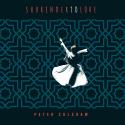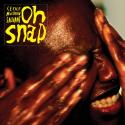Although American, Sparks’ initial commercial breakthrough was in the UK where their rococo art-rock chimed with ears attuned to, say, Roxy Music. Their sensibility has always been more European than American. In 2009 they issued an album titled The Seduction of Ingmar Bergman. Its theme was a flight of fancy which took the Swedish director to Hollywood. Later, in 2015, Sparks and Franz Ferdinand collaborated as FFS. As ever, Sparks were a bridge between Europe and the USA.
Another indication of this inclination was their 1979 album No. 1 In Heaven. Newly reissued to mark its 40th anniversary, it began a new phase in Sparks’ career: one initiated by exposure to Donna Summer’s Munich-recorded “I Feel Love”.
 According to Sparks’ Russell Mael, “I Feel Love” had “sent a chill down our collective spine.” In the No. 1 In Heaven reissue's booklet, he goes on to say “those electronics and soulful human voice – what was that?” During a 1978 interview with a German journalist, Sparks had claimed their next album was going to be made with “I Feel Love’s” co-producer and co-writer Giorgio Moroder. No such plans had been made. Their bluff was called when the journalist revealed she knew the producer and put them in touch with him. At this point, Sparks were promoting their unsatisfactory 1977 album Introducing Sparks, where they had smoothed off the edges of their innate quirkiness in an attempt to embrace a classic American sound. No. 1 In Heaven was different. And new.
According to Sparks’ Russell Mael, “I Feel Love” had “sent a chill down our collective spine.” In the No. 1 In Heaven reissue's booklet, he goes on to say “those electronics and soulful human voice – what was that?” During a 1978 interview with a German journalist, Sparks had claimed their next album was going to be made with “I Feel Love’s” co-producer and co-writer Giorgio Moroder. No such plans had been made. Their bluff was called when the journalist revealed she knew the producer and put them in touch with him. At this point, Sparks were promoting their unsatisfactory 1977 album Introducing Sparks, where they had smoothed off the edges of their innate quirkiness in an attempt to embrace a classic American sound. No. 1 In Heaven was different. And new.
After the release of “I Feel Love” in July 1977, a gradual but noticeable shift occurred in how a set of exploratory bands approached their music. The synthesiser was an important shared ingredient, but it was the disco hit’s rhythm and synthetic base which induced change.
 Like Sparks, Japan were smitten, so in 1979 they recorded the “Life in Tokyo” single with Moroder. He co-wrote it with the band’s David Sylvian. Simple Minds’ September 1980 single “I Travel” could not have existed without “I Feel Love”, nor could Roxy Music’s “Angel Eyes” (first heard as an album track in March 1979). On all fronts, Sparks had got there got their already. The Three Degrees aside, they were first pre-existing band to work with Moroder. No. 1 In Heaven was made with Moroder in 1978 and issued in March 1979, a month before “Life in Tokyo” came out.
Like Sparks, Japan were smitten, so in 1979 they recorded the “Life in Tokyo” single with Moroder. He co-wrote it with the band’s David Sylvian. Simple Minds’ September 1980 single “I Travel” could not have existed without “I Feel Love”, nor could Roxy Music’s “Angel Eyes” (first heard as an album track in March 1979). On all fronts, Sparks had got there got their already. The Three Degrees aside, they were first pre-existing band to work with Moroder. No. 1 In Heaven was made with Moroder in 1978 and issued in March 1979, a month before “Life in Tokyo” came out.
After No. 1 In Heaven was completed with Moroder in Los Angeles (in the booklet, it is admitted that despite its original credits it was not recorded at Moroder’s Munich studio), Sparks tried to get labels interested. Russell Mael says “not one enlightened record label immediately wanted to get behind our effort. It didn’t fit in.” Eventually, a Munich-based member of Virgin Records’ staff listened, got it and the album was issued in March 1979, a year after it was completed.
Forty years on, the album is expanded to a two-disc set. The album itself is on Disc One and the second disc collects longer and shorter single versions, the two Peter Cook-voiced promo spots which were on 12-inch 45s and a recently found alternate version of “Tryouts For the Human Race”. The reissue comes on CD and vinyl, but the latter was not supplied for review and is not addressed here.
 Partly, No. 1 In Heaven’s impact is to do with Russell Mael’s ever-distinctive vocals – which always place Sparks outside anything in the moment – but it’s more a consequence of how their music had been reframed. In the booklet, it’s noted that Ron Mael wrote “Beat the Clock” on an acoustic guitar and was aiming for a Velvet Underground feel. In the end, it became soaring and insistently rhythm-bedded. Russell couldn’t contain his longing to yodel the word “clock.” There are also hints of The Man-Machine Kraftwerk of 1978 and suggestions of where New Order arrived in 1982 with “Temptation”. Moroder is by birth Italian and while “La Dolce Vita” has an Italo-disco feel, it points to what would be dubbed Hi-NRG around 1982 and 1983. As it was with working with Moroder, Sparks were looking forward: in this case around four to five years ahead.
Partly, No. 1 In Heaven’s impact is to do with Russell Mael’s ever-distinctive vocals – which always place Sparks outside anything in the moment – but it’s more a consequence of how their music had been reframed. In the booklet, it’s noted that Ron Mael wrote “Beat the Clock” on an acoustic guitar and was aiming for a Velvet Underground feel. In the end, it became soaring and insistently rhythm-bedded. Russell couldn’t contain his longing to yodel the word “clock.” There are also hints of The Man-Machine Kraftwerk of 1978 and suggestions of where New Order arrived in 1982 with “Temptation”. Moroder is by birth Italian and while “La Dolce Vita” has an Italo-disco feel, it points to what would be dubbed Hi-NRG around 1982 and 1983. As it was with working with Moroder, Sparks were looking forward: in this case around four to five years ahead.
Beyond its prescience, No. 1 In Heaven also scores heavily due to its songs. “My Other Voice”, where Russell adopts a slightly lower register than usual, is yearning, otherworldly, mostly instrumental and beautiful. It’s a wonder David Lynch hasn’t co-opted it at some point. “Academy Award Performance” is more manic and sports another instantly unforgettable melody.
The new reissue – on CD at least – has been remastered with a greater dynamic range than the original album. Those already owning No. 1 In Heaven know it’s a terrific album which sounds incredibly fresh and not of its time. Those without a copy are directed to get one, and the 40th-anniverary reissue is as handy a way to do so as any.
- Next week: Refurbished editions of The Residents’ Eskimo and Commercial Album
- Read more reissue reviews on theartsdesk
- Kieron Tyler’s website















Add comment